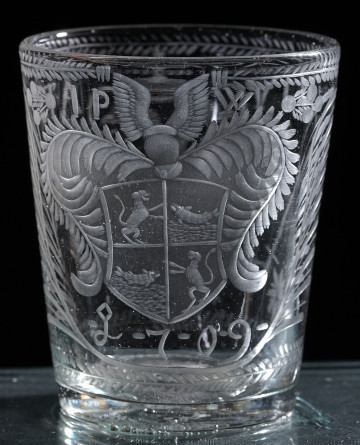
Bottle with the coat of arms of "Trąby" and "Waga"
18th century
Castle Museum in Łańcut
Part of the collection: Glass
The drinking flute was made in the first half of the 18th c., probably in the glass factory near Lubaczów known as Huta Kryształowa ('Crystal Glassworks'), established in 1717 by the hetman Adam Mikołaj Sieniawski. He was married to Elżbieta Lubomirska, daughter of Stanisław Herakliusz Lubomirski - the owner of the Łańcut castle in the years 1699-1702. In the Łańcut Polish glassware collection, products from these nearby glassworks are the majority. It was one of the oldest Polish glass factories that achieved a very high, European craft level in its products. It was headed by Franciszek Fremel, an outstanding Saxon specialist, brought to Poland in 1710 by Augustus II the Strong. The glassworks were active throughout the 18th century. It produced glass tableware and candlesticks. Champagne flutes with a narrow and slender bowl on a baluster stem and a round foot were distinctive among toasting glasses. The above drinking flute is made of thick, clear glass. It has a large, flat, round foot with a distinctive stem in the shape of glass knots arranged in three rows. The bowl is slender, conical, and ribbed.
Author / creator
Dimensions
height: 34 cm
Object type
Glass
Technique
cutting
Material
glass
Creation time / dating
Creation / finding place
Owner
Castle Museum in Łańcut
Identification number
Location / status

18th century
Castle Museum in Łańcut

18th century
Castle Museum in Łańcut

Castle Museum in Łańcut
DISCOVER this TOPIC
National Museum in Szczecin
DISCOVER this PATH
Educational path